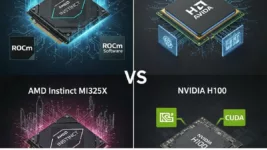For too long, the AI hardware landscape has felt like a one-horse race, with NVIDIA’s H100 GPUs dominating the field. But here in Bend, Oregon, where a healthy dose of competition keeps everyone sharp, AMD is increasingly proving that not only are they in the race, but they’re making a strong bid for the lead. Their recent MLPerf Training submission, highlighting the prowess of the AMD Instinct MI300 and the upcoming MI325X GPUs, signals a significant shift in the AI training arena. In an era of hardware availability constraints, all AMD has to be is “good enough” – and they are clearly outperforming that bar, pushing the boundaries and offering compelling alternatives.
A Major Milestone: AMD’s MLPerf Training Debut
AMD’s recent entry into the MLPerf Training v5.0 benchmarks marks a pivotal moment. This wasn’t just a quiet submission; it was a loud declaration of intent, showcasing the strength of their platform with competitive performance on both the Instinct MI300X and the Instinct MI325X GPUs. The chosen workload, fine-tuning the Llama 2-70B-LoRA model, is no lightweight; it’s a widely adopted and critical task for customizing large language models in today’s generative AI landscape. This highlights AMD’s focus on real-world, highly relevant AI workloads rather than abstract benchmarks.
The debut results are particularly impressive: the Instinct MI325X platform actually outperformed an average of six OEM submissions using NVIDIA’s H200 platform by up to 8% when fine-tuning Llama 2-70B-LoRA, a widely adopted workload for customizing large language models. This isn’t just “good enough”; this is superior performance in a crucial segment. The Instinct MI300X platforms also delivered competitive performance against NVIDIA H100 on the same workload, validating both GPU platforms in the Instinct MI300 Series as strong contenders across a broad range of training needs, from enterprise applications to cloud-scale environments.
Industry-Wide Validation and Ecosystem Strength
What truly amplifies AMD’s MLPerf debut is the industry-wide validation from its ecosystem partners. In addition to AMD’s own submission, six OEM partners submitted MLPerf Training results using AMD Instinct MI300 Series GPUs. This demonstrates that AMD Instinct performance is not just a lab benchmark; it’s reproducible and robust across a wide range of diverse platforms and configurations. These partner results reinforce the consistent performance of the MI300X and MI325X across various infrastructure environments, even setting new industry milestones in several cases.
A standout example comes from Supermicro, which became the first company ever to submit training results to MLPerf using a liquid-cooled AMD Instinct solution (Supermicro liquid-cooled MI325X MLPerf). Their liquid-cooled Instinct MI325X platform achieved an impressive time-to-train score of 21.75 minutes, not only showcasing top-tier performance but also highlighting the thermal efficiency and scaling potential of advanced cooling solutions in dense AI deployments. MangoBoost further raised the bar with groundbreaking multi-node submissions, demonstrating the scalability of the MI300X platform in distributed AI infrastructure. Dell, Oracle, Gigabyte, and QCT also contributed strong results, collectively proving the power, flexibility, and openness of AMD Instinct GPUs, which are clearly being embraced and pushed to new heights by innovators across the ecosystem.
ROCm Software: The Open-Source Secret Sauce
The remarkable performance gains showcased by AMD are significantly powered by the rapid evolution of AMD ROCm™ v6.5 software, AMD’s open software stack. Over the past year, ROCm has matured into a robust training platform. In the Llama 2-70B-LoRA fine-tuning task, ROCm was key to unlocking top-tier performance on Instinct MI325X and MI300X GPUs, with critical improvements like Flash Attention, Transformer Engine support, and optimizer-level tuning. AMD has even released optimized docker containers used in this work, along with easy-to-use reproduction instructions, empowering developers. These results provide strong evidence that an open software stack, backed by deep engineering optimizations, can indeed rival and, in some cases, outperform proprietary ecosystems. For customers scaling generative AI, ROCm software delivers the performance, flexibility, and developer support needed to move fast and efficiently.
A Significant Generational Leap
In AI infrastructure, staying current is essential. Organizations investing in AI expect meaningful performance gains with each new platform. The AMD Instinct MI325X GPU sets a new standard for what a generational leap can deliver. In platform (8-GPU) fine-tuning workloads like Llama 2-70B-LoRA, the Instinct MI325X offers up to a 30% performance uplift compared to the Instinct MI300X, a significant generational advancement that dramatically accelerates large-scale AI development and shortens training timelines.
Wrapping Up: The Future is Open and Accelerated with AMD
AMD’s debut MLPerf training submission marks a major milestone, signaling that their Instinct MI300 Series GPUs provide customers with compelling new options for scaling AI innovation. With competitive, and in some cases, superior performance on key AI workloads, and a robust, open ROCm software stack, AMD is rapidly closing the gap on NVIDIA’s long-standing dominance. In a market where hardware availability can often be a constraint, AMD’s ability to be “good enough” has now evolved into being a genuine leader in crucial AI training workloads. As models grow larger and AI use cases expand, AMD’s commitment to open, high-performance solutions promises to empower customers to train, fine-tune, and deploy AI faster and more flexibly than ever before. The momentum behind AMD Instinct is real, and it’s just getting started








